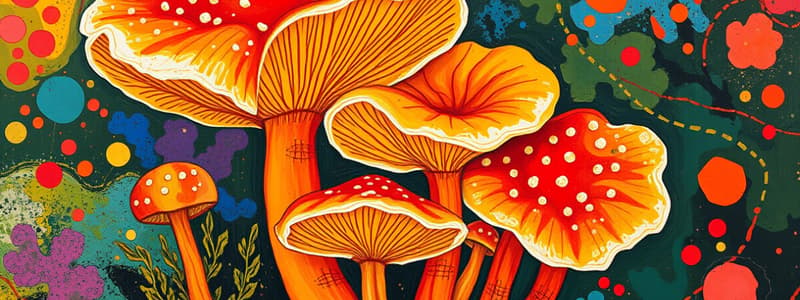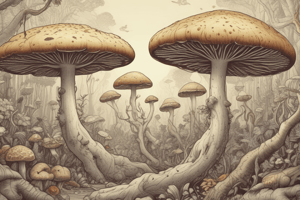Podcast
Questions and Answers
Fungi are heterotrophs and absorb nutrients from outside of their bodies.
Fungi are heterotrophs and absorb nutrients from outside of their bodies.
True (A)
Fungi are heterotrophic eukaryotes that include only yeast and molds.
Fungi are heterotrophic eukaryotes that include only yeast and molds.
False (B)
Why are fungi essential for the well-being of most terrestrial ecosystems?
Why are fungi essential for the well-being of most terrestrial ecosystems?
Because they break down organic material and recycle vital nutrients.
What is the largest organism on earth?
What is the largest organism on earth?
What are the characteristics of fungi?
What are the characteristics of fungi?
What is one key trait of all fungi?
What is one key trait of all fungi?
Fungi are autotrophs and absorb nutrients from outside of their bodies.
Fungi are autotrophs and absorb nutrients from outside of their bodies.
What do fungi use to break down a large variety of complex molecules?
What do fungi use to break down a large variety of complex molecules?
What are the functions of fungi?
What are the functions of fungi?
What are the most common body structures of fungi?
What are the most common body structures of fungi?
Some fungal species grow as either filaments or yeasts; others grow as both.
Some fungal species grow as either filaments or yeasts; others grow as both.
The morphology of multicellular fungi does not enhance their ability to absorb nutrients.
The morphology of multicellular fungi does not enhance their ability to absorb nutrients.
What is mycelia?
What is mycelia?
What makes up fungal cell walls?
What makes up fungal cell walls?
What do septa do in fungi?
What do septa do in fungi?
What do pores in septa allow?
What do pores in septa allow?
What are coenocytic fungi?
What are coenocytic fungi?
Nutrients absorbed by the hyphae can flow throughout the mycelium in both coenocytic hyphae and septate hyphae.
Nutrients absorbed by the hyphae can flow throughout the mycelium in both coenocytic hyphae and septate hyphae.
What forms can fungal cells take?
What forms can fungal cells take?
Where do mycelia release digestive enzymes?
Where do mycelia release digestive enzymes?
What process do basidia use to produce spores?
What process do basidia use to produce spores?
What are basidia?
What are basidia?
What term describes the fusion of cytoplasm from two individuals?
What term describes the fusion of cytoplasm from two individuals?
Mycelium is directly involved in the reproduction of at least one major group of fungi.
Mycelium is directly involved in the reproduction of at least one major group of fungi.
In most fungi, fertilization is a two-step process consisting of the fusion of cells and then the fusion of nuclei in the fused cells.
In most fungi, fertilization is a two-step process consisting of the fusion of cells and then the fusion of nuclei in the fused cells.
Where does meiosis occur in a mushroom?
Where does meiosis occur in a mushroom?
What event occurs first in the development of a spore into a mature mushroom?
What event occurs first in the development of a spore into a mature mushroom?
Most of the cells in a mushroom contain diploid nuclei.
Most of the cells in a mushroom contain diploid nuclei.
What is a key difference between fungi and plants?
What is a key difference between fungi and plants?
How do fungi obtain nutrients?
How do fungi obtain nutrients?
What are mycorrhizae?
What are mycorrhizae?
What do mycorrhizal fungi deliver to plants, and what do the plants provide the fungi?
What do mycorrhizal fungi deliver to plants, and what do the plants provide the fungi?
Most vascular plants have mycorrhizae.
Most vascular plants have mycorrhizae.
What are ectomycorrhizae?
What are ectomycorrhizae?
What are arbuscular mycorrhizae?
What are arbuscular mycorrhizae?
Fungal cells are normally haploid, except when transient diploid stages form during the sexual life cycle.
Fungal cells are normally haploid, except when transient diploid stages form during the sexual life cycle.
What are pheromones in fungi?
What are pheromones in fungi?
What is a heterokaryon?
What is a heterokaryon?
What does dikaryotic mean?
What does dikaryotic mean?
What is karyogamy?
What is karyogamy?
Molds are filamentous fungi that produce diploid spores and form visible mycelia.
Molds are filamentous fungi that produce diploid spores and form visible mycelia.
Yeasts do not produce spores. Instead, they undergo budding.
Yeasts do not produce spores. Instead, they undergo budding.
What are deuteromycetes?
What are deuteromycetes?
What are the reasons for why fungi are more closely related to animals than to plants?
What are the reasons for why fungi are more closely related to animals than to plants?
Fungi, animals, and their protistan relatives are in the supergroup ____________ and the clade ____________.
Fungi, animals, and their protistan relatives are in the supergroup ____________ and the clade ____________.
DNA evidence suggests that fungi are most closely related to unicellular protists called _______ and animals are most closely related to unicellular protists called ______.
DNA evidence suggests that fungi are most closely related to unicellular protists called _______ and animals are most closely related to unicellular protists called ______.
Phylum (common name): Basidiomycota:
Phylum (common name): Basidiomycota:
Phylum: Ascomycota:
Phylum: Ascomycota:
Phylum: Glomeromycota:
Phylum: Glomeromycota:
Phylum: Zygomycota:
Phylum: Zygomycota:
Phylum: Chytridiomycota:
Phylum: Chytridiomycota:
What is a lichen?
What is a lichen?
What does the fungus give to the lichen?
What does the fungus give to the lichen?
What does the photosynthetic partner give to the lichen?
What does the photosynthetic partner give to the lichen?
What are endophytes?
What are endophytes?
What is mycosis?
What is mycosis?
What are practical uses of fungi?
What are practical uses of fungi?
What is ergotism?
What is ergotism?
Flashcards are hidden until you start studying
Study Notes
Fungi Overview
- Fungi are heterotrophs and absorb nutrients from their surroundings.
- They include yeast, molds, and mushrooms, making them diverse eukaryotic organisms.
Ecological Importance
- Act as decomposers, breaking down organic material and recycling nutrients vital for terrestrial ecosystems.
Largest Organism
- Armillaria ostoyae in Oregon is the largest known organism, covering approximately 2000 acres and estimated to be around 2000 years old.
Fungal Characteristics
- Fungi can be unicellular (yeasts) or multicellular (molds and mushrooms) and inhabit terrestrial or aquatic environments.
- Reproduction occurs both sexually and asexually, with closer genetic ties to animals than plants.
Key Nutritional Traits
- Fungi utilize exoenzymes to decompose complex molecules into smaller organic compounds.
Fungal Roles
- Play multiple roles:
- Decomposers (saprobes)
- Parasites
- Mutualists
Body Structure
- Mycelia are formed from hyphae (multicellular filaments) and maximize surface area for absorption.
- Cell walls consist of chitin, functioning as a protective layer.
Hyphal Structure
- Hyphae can be septate (divided by septa) or coenocytic (lacking septa).
- Pores in septa allow nutrient and cell content flow between cells.
Fungal Cell Types
- Monokaryotic (one nucleus), dikaryotic (two nuclei), and multinucleate cells (multiple nuclei due to incomplete division).
Digestion and Spores
- Fungi release digestive enzymes into their environment to decompose organic material.
- Basidia, located in mushroom gills, produce spores via meiosis.
Reproductive Processes
- Plasmogamy is the cytoplasmic fusion process, followed by karyogamy, where nuclei fuse, resulting in a diploid stage.
- Mycelium itself does not directly participate in reproduction.
Mycorrhizae
- Symbiotic relationships between fungi and plant roots, facilitating nutrient exchange; plants provide carbohydrates, while fungi deliver phosphates and minerals.
Types of Mycorrhizae
- Ectomycorrhizae form sheaths around roots, while arbuscular mycorrhizae penetrate root cell walls.
Fungal Life Cycle
- Most fungi exist primarily as haploid cells, with diploid cells forming only transiently during reproduction.
- Pheromones help detect mating types, facilitating sexual reproduction.
Key Fungal Phyla
- Basidiomycota (club fungi): Key features include basidiospores and basidiocarps like mushrooms.
- Ascomycota (sac fungi): Known for producing conidiospores asexually and forming ascocarps.
- Glomeromycota (AM fungi): Form arbuscules associated with plant symbiosis.
- Zygomycota (zygospore fungi): Produce zygospores and are commonly found in decaying organic matter.
- Chytridiomycota (chytrid fungi): Simplest fungi with flagellated spores and aquatic habitat.
Lichens and Endophytes
- Lichens are mutualistic associations between fungi and photosynthetic organisms; fungi provide structure and protection, while partners provide nutrients.
- Endophytes exist within plants, offering defensive toxins against herbivores and pathogens.
Human Impact and Uses
- Fungi are pivotal in food production and antibiotics development.
- Fungal infections in animals are termed mycosis, with conditions like ergotism caused by toxins from Claviceps purpurea impacting human health.
Studying That Suits You
Use AI to generate personalized quizzes and flashcards to suit your learning preferences.




